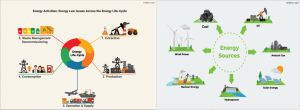[vc_row css=”.vc_custom_1565542682041{margin-right: 0px !important;margin-left: 0px !important;}”][vc_column css=”.vc_custom_1565542696462{padding-right: 0px !important;padding-left: 0px !important;}”][vc_single_image image=”9868″ img_size=”1440X330″ el_class=”banner-event”][/vc_column][/vc_row][vc_row css=”.vc_custom_1565542751414{margin-right: 0px !important;margin-left: 0px !important;}”][vc_column width=”1/4″][/vc_column][vc_column width=”1/2″ css=”.vc_custom_1565622195563{padding-bottom: 50px !important;}”][vc_column_text el_class=”title-event”][post_title][/vc_column_text][vc_column_text el_class=”author-pers”]By Raphael Heffron, Monika Merdekawati, Beni Suryadi and Zulfikar Yurnaidi[/vc_column_text][vc_column_text el_class=”date-venue-news”][post_date][/vc_column_text][vc_column_text el_class=”text-par-news”]Introduction – The Call for Just Energy Investments
Timelines are of vital importance to the transition to a low-carbon economy. Many countries have energy and climate goals from 2025 to 2030 and beyond 2040 and 2050. Therefore, a key issue is clearly how investment in the energy sector will happen and be managed over these time periods. Further, it is necessary that this investment contributes to justice in the energy sector, i.e. that the investment results in ‘just’ outcomes for society.
Justice issues are on the rise. For example, conditions in society have been changing for multiple reasons but the increase in data, rise in availability of technology, the financial crisis of 2007-2009, COVID-19 and now the 2020 financial crisis have created what can be referred to as a ‘perfect storm’ for applying justice to energy projects. A significance of addressing these risks is that with greater justice, there will be a reduction in the commercial risk of future projects.
This short blog article focuses on the investments needed in the energy sector and how these investments need to be just. We advance that ‘just energy investments’ (JEI) need to happen. We aim here in this blog piece and as part of future research to define what the definition of a just energy investment is.
Defining Just Energy Investments
Energy investments is a very broad term. However, at first stance these can be classified in different ways such as based on energy activities (for example, extraction, operation, consumption) or energy sources themselves (for example, coal, gas etc.); see below, in Figure 1 which highlights the key energy activities and energy sources where we can determine that investments are made.
Figure 1: Energy Activities and Energy Sources

Source: Created by Heffron (2020)
Whichever way we think about energy investments as activities or sources, there is a multitude of reports which indicate a huge amount of investment needed in the energy sector by 2030, 2040 and 2050. The significant amounts mentioned such as $120 trillion (estimated for 2015-2050) globally for the energy transition are quite conservative when we realise that new investment is needed to meet new energy demand (due to population rises) but also to replace old infrastructure and to replace fossil fuel infrastructure. Is this what a just energy investment will include?
Indeed, at the very least just energy investments (JEI) will include these latter types of investments, but there is a broader question here. A JEI should result in a just outcome for society, and this in essence means that as long as investment puts a society on the pathway to a just transition to a low-carbon economy. Hence, we should also consider the rules of investment.
Considering Rules of Energy Investment
There are different types of rules of investment. Some are related to design; consider, for example, issues such as 1) access to green finance (2) innovation in finances; (3) barriers to new technology; and (4) challenges from incumbent conventional companies. These reflect the design of the market that companies participate in within the energy sector. A definition for JEI needs to factor this in too.
In addition, and as important are further rules and terminology around energy investments. For example, there are four significant areas here which are sustainable, climate, green, and transition finance which are set out in brief below.
(1) Sustainable Finance
The most widely accepted definition of sustainable finance is that the financing activities to support climate mitigation and adaptation to achieve the targets of the Paris Agreement and United Nations (UN) Sustainable Development Goals (SDGs) as adopted by the private sector in the Climate Bonds Initiative (CBI). However, there are diverse interpretations of which categories of projects fall into a sustainable investment, causing differences in policies between governments.
Amongst OECD countries, China, European Union (EU), France, Japan, and the Netherlands have defined the sustainable category for green bonds and green loans in legislation, except for Japan where has no green loan definition. Furthermore, France and the Netherlands have established the framework for sovereign green bonds which is based on the CBI taxonomy.
Generally, international finance actors have the same perception that renewable energy and green buildings are within a sustainable definition. While the criteria for inclusion of non-renewable energy, i.e., nuclear, supercritical coal (clean coal), and gas-fired power, varies across jurisdictions. For example, only in China, is clean coal is eligible for sustainable finance. Nuclear is also considered as clean energy by China and CBI, and gas by China and the EU. In terms of coverage, EU taxonomy is the most comprehensive, the only one that includes carbon-intensive industry sectors such as cement and steel.
(2) Climate Finance
The United Nations Framework Convention on Climate Change (UNFCCC) defined climate finance as financing that seeks to support mitigation and adaptation actions that will address climate change. This includes multilateral climate funds such as Green Climate Fund (GCF), Global Environment Facility (GEF), Adaptation Fund (AF), and Climate Investment Fund (CIF); other public funds; and private funds. Climate Policy Initiative (CPI) estimated that climate finance flow has been growing from 342 billion USD in 2013 to 546 billion USD in 2018.
(3) Green Finance
Green finance is another concept that is similar and in general, the definition focuses on finance where environmental and social factors are taken into account. In addition, there is some verification process to show that there is an environmental benefit.
(4) Transition Finance
Another related concept of “finance” would be transition finance, introduced by OECD. Defining “transition” as the journey towards the 2030 Agenda of Sustainable Development, transition finance is a concept of ensuring that countries can have a smooth transition, in term of development finance, between developmental stages. Specifically, how countries would transition from Official Development Assistance (ODA) to domestic and foreign investment.
Moreover, there have been several initiatives that explore rules of investment that would contribute to a just transition to a low-carbon economy. These come from several research institutes such as the Universities of Harvard and the London School of Economics, and the Overseas Development Institute (via support by HSBC, the international bank). These reports reflect a broader view than what we are aiming for in that they focus on the wider transition to a low-carbon economy – i.e. they focus on many sectors of the economy whereas our research has a narrower focus on the energy sector itself.
A final consideration has to be factored into a definition for a JEI and that has to be the energy transition trajectory of a country. Some countries may be moving at a slower pace in the energy transition, while others may be working from a problematic energy mix. Hence, investments made that deliver results for 2030 energy and climate goals may be different from country to country. Can this be factored in also by the rules-based approach? Our approach is advanced below.
Our Definition of a Just Energy Investment
The essence of the issue here is that in order to achieve a 2030 energy or policy goal that will deliver a transition to a low-carbon economy the law needs to be changed, reformed etc. at least a reasonable length of time before that – for example, one would need to think before 2022 at the latest to achieve 2030 goals. A key reason why this is necessary is to ensure that there is a stable legal structure around the activity, i.e. this legal stability is referred to as legal certainty. This legal certainty provides confidence to investors who can then make an investment decision knowing that they will be able to secure a return on their investment and that their investment is protected (to some degree).
Our definition of ‘just energy investments’ is where a just energy outcome is secured for society from an energy investment that matches its’ energy and climate societal goals over the medium to long-term and financing is in accordance with a set of just principles. This is our definition with which we begin and will further develop in future research.[/vc_column_text][vc_column_text el_class=”photo-caption-news”](Photo Credit: Jason Blackeye, Unsplash)[/vc_column_text][/vc_column][vc_column width=”1/4″][/vc_column][/vc_row]











